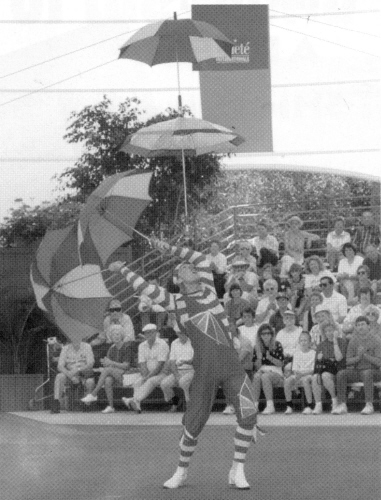
Kreis "hops" his stack of two in the air to swing another over his head. |
Page 19 Fall 1995
|
Kreis
Chooses Umbrellas
as Prop of Choice By John Nations
If
a colorful cascade of tumbling umbrellas catches your eye on a trip to
central Florida,
Since
the dissolution of the Soviet Union, many Russian and Ukranian jugglers
have traveled westward in search of new audiences and better pay. Kreis
(pronounced to rhyme
Like
most Russian circus artists, Kreis is well versed in many aspects of
physical comedy and acrobatics. The Akishins specialize in spectacular
jump rope tricks, and Iouri used to perform as part of their team show.
Recently, though, he has been a featured solo act performing with his
uncommon prop. Wearing
full clown makeup, Kreis crouches and waddles into the circus ring
hidden between four open umbrellas held in a dome shape around
The
umbrella's shape makes it fall more slowly, which allows Kreis to propel
it upward from his forehead while balancing it, as if head-bouncing a
ball. The umbrella appears to hop up
Then
the juggling begins. To the music of Mancini's "Pink Panther
Theme,"
Kreis
was born in Murmansk, Russia, on March 8, 1962. He is the only circus
performer in his family: He studied tap dancing and comic acrobatics at
the Maslukov (1975-80) and Moscow (1986-91) circus schools, and learned
to juggle five each of balls, clubs and rings.
But
since everyone seemed to be performing similar juggling tricks, Kreis
looked
During
his most recent appearances at Cypress Gardens, Kreis has also been
performing "Nanaika," the Eskimo dance. This piece must be
seen to be appreciated! Two three-foot Eskimo puppets, grasping each
other firmly about the shoulders, rise up out of a small box in the ring
and begin to dance and hop around. They begin to tussle and kick at each
other, twirl around, tumble into the audience, and eventually climb
tandem up onto a chair.
Their
cartoonish movement suggests something unusual, and at the end of the
dance, one Eskimo stands up, revealing that a stretched-out Kreis
controls both dancers! The comical style and choreography of the "Nanaika"
make the audience laugh, but the act requires serious stamina and
control on the part of the performer.
Fortunately,
Iouri is in excellent shape. He used to jump rope as part of a
three-person tower, and jumped solo on his hands, propelling himself off
the ground from a handstand for every pass of the rope! Needless
to say, the trick takes a toll on the performer's wrists, and Iouri is
glad to be focusing on juggling now.
While
Kreis continues performs with umbrellas, he is interested in buying some
clubs to use for shows outside the circus ring. He is good with kickups,
and can stand on a chair and catch helicopter drops on his foot
without the aid of the floor.
Kreis
also has an interesting variation on floaters: he tosses them with the
clubs totally vertical, bulb upward, in a cascade. He expressed interest
in attending an IJA festival to see American juggling and shop the
vendors' tables.
Kreis's
favorite jugglers are Valentin Tchirnov, Rudy Schweitzer, Eugeny Bilauer,
and Sergei Ignatov. He said that the best thing about the opening of the
former Soviet Union is the freedom to travel, and especially for
performers to seek good jobs in other countries. The down side is that,
with curtailed state funding, circuses and circus schools in
Also,
many of the best artists have left Russia for the West. Vladimir Tsarkov
is in Switzerland, and Gregory Popovich and Anatoly Myaskostuvopov are
in Las Vegas. Kreis said that even Eugeny Bilauer, the famous club
master, is working somewhere in western Europe. Despite its shrinking
budget, however, Kreis thinks the Russian circus will survive to
continue its rich tradition. He said he plans to return to Russia
eventually, at least to visit and perform.
For
the time being, though, he'll stay in the States with his young family:
While at Cypress Gardens, Iouri met and married Tracy: They now live in
Winter Haven with two daughters, |

Kreis "hops" his stack of two in the air to swing another over his head. |